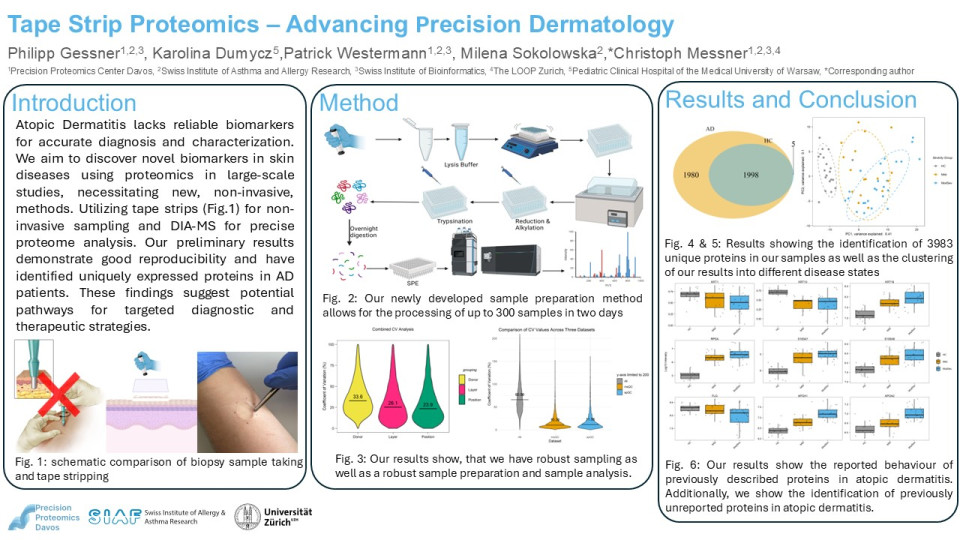Dermatological disorders are estimated to affect around 1 billion people at any point in time and have a heavy impact on the global population as the 4th leading cause of non-fatal disease burden. This is exacerbated by the lack of personalized and precision medicine available to treat diseases such as atopic dermatitis, psoriasis, and malignant skin carcinoma. Atopic dermatitis especially suffers from a lack of reliable biomarkers to diagnose and characterize the clinical phenotype as well as provide personalized medication and a better understanding of the disease mechanism. Especially pediatric patients are affected by it. This can have further implications not only on their quality of life but even impact their mental health.
Therefore, our objective is to identify these biomarkers and elucidate the underlying disease mechanism through one of the most comprehensive analyses performed so far. For this, we leverage high throughput, bottom-up, proteomics and our newly developed tape strips proteomic workflow to quickly and efficiently sample patients, analyse samples and generate insights. Current methods often rely on biopsies, which can be challenging to obtain, particularly from pediatric patients. Alternatively, when using tape strips, they require the combination of multiple strips, identify fewer proteins, or depend on lengthy gradients during analysis. In contrast, our newly developed tape strip proteomics workflow allows us to non-invasively sample patient cohorts and enables us to also sample pediatric patients.
Our workflow is unbiased and untargeted and combines the Orbitrap Eclipse and EasynLC 1200 as well as DIA-NN. It is capable of identifying between 800-1000 protein per layer of tape in healthy donors and up to 3000 proteins in diseased donors. Additionally, it is unique in its capabilities to analyse a singular layer in a 30-minute gradient. This allows us to prepare up to 400 samples in 2 days, analyse them in a time span of two weeks and identify differences in skin layers. This capability in combination with our collaborations allows us to perform population-wide skin studies which are unique in their reach. For this, we have measured and analyse 70 samples from one cohort, which we have received from our collaborators, in a pilot study. It shows a very low variability in our quality control samples and thus verifies the robustness of our methodology. We identified 300 significantly differentially expressed proteins and measured 3982 unique proteins. We will build upon these preliminary results and conduct a secondary study. It will involve 300 samples from a second cohort and further our knowledge of the disease mechanism of Atopic Dermatitis. We expect to generate valuable new insights into the epithelia barrier and underlying conditions for atopic dermatitis.
In summary, we aim to conduct population-wide proteomic analysis to elucidate the underlying mechanisms of atopic dermatitis and aim to discover and verify biomarkers which can help to enable precision dermatology. To this length, we have already analysed one cohort and are actively working on processing the second cohort as well as their analysis. In the future we aim to further simplify our processes and increase our throughput as well as the number of detectable proteins.
Quiz question
Was ist das Besondere an der neuen Methode zur Analyse von Hautproben in Tape Strip Proteomics?
Die Methode kombiniert mehrere Klebestreifen und kann damit bis zu 2000 Proteine identifizieren. Die Analyse einer Probe dauert eine Stunde, wodurch 200 Proben pro Monat untersucht werden können.
Die Methode nutzt spezielle Hightech-Klebestreifen und künstliche Intelligenz, um in 15 Minuten bis zu 500 Proteine zu identifizieren, was die Analyse von 1000 Proben pro Monat ermöglicht.
Mit einem einzelnen Klebestreifen können in 45 Minuten 800-1000 Proteine bei gesunden und bis zu 3000 Proteine bei erkrankten Personen nachgewiesen werden. Das Team kann bis zu 400 Proben in zwei Wochen analysieren.
